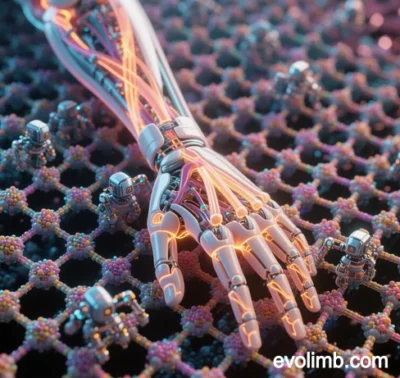
Evo Limb: Breakthroughs in Bionic Prosthetics, Exoskeletons, and Biohybrid Technologies
The convergence of neuroscience, materials engineering, and artificial intelligence has propelled bionic prosthetics and exoskeletons into a new era of bioelectronic symbiosis. This article explores three core technological advancements—bionic prosthetics, smart exoskeletons, and biohybrid interfaces—highlighting their scientific principles and cross-domain applications.
I. Bionic Prosthetics: From Dynamic Control to Multimodal Perception
- Neurally Controlled Bionic Systems:
- MIT Biohybrid Prosthetic: Combines regenerative tissue with titanium frameworks, enabling direct neural signal control via BION microchips. Its shape-memory alloy (SMA) joints mimic ankle biomechanics, reducing gait errors.
- Ottobock Symbionic Leg: Features energy-recovery systems that convert knee motion into electrical power. Its gradient carbon-fiber arch adapts to terrain slopes, minimizing fall risks.
- Multimodal Sensory Restoration:
- Tactile-Temperature Feedback: Devices like SEM Glove™ use microelectrode arrays to restore pressure, vibration, and temperature perception, enhancing environmental interaction.
- Quantum Tactile Sensors: Diamond-based probes detect neuron-level strain for ultra-early Parkinson’s diagnosis.
II. Smart Exoskeletons: From Industrial Aid to Neural Remodeling
- Industrial Exoskeletons:
- EVO Exoskeleton: Employs low-profile multi-link structures and modular harnesses to support overhead, cross-body, and rear-reaching tasks. Adaptive impedance control reduces muscle fatigue in factory workers.
- Medical Rehabilitation Exoskeletons:
- EksoNR: Integrates EMG/EEG signals to adjust gait-assist torque, improving walking symmetry in stroke patients.
- HAL-ML: Uses brain-machine interfaces to decode motion intent, enhancing walking speed in spinal injury patients.
III. Biohybrid Interfaces: From Mechanical Links to Neural Integration
- Osseointegration and Neural Regrowth:
- Titanium Bone Implants: Fuse with bone via osseointegration, reducing metabolic strain and skin complications.
- Cambridge Biohybrid Interface: Flexible electrodes coupled with nerves restore motor and tactile functions in paralyzed subjects.
- Synthetic Biological Circuits:
- Optogenetic Control: Engineered astrocytes release lactate under near-infrared light, reversing synaptic loss post-trauma.
- 3D-Bioprinted Tactile Organs: Restore temperature and pressure perception in burn patients with bioengineered Merkel cell structures.
IV. Challenges and Future Directions
- Technical Barriers:
- Energy density limitations in prosthetic actuators.
- Long-term biocompatibility of implanted electrodes.
- Emerging Innovations:
- Quantum-Bio Interfaces: Diamond nanoprobes monitor neural activity to predict seizures.
- Cloud-Driven Neurorehabilitation: Personalized training protocols using large-scale haptic data.
V. Ethical and Societal Impact
- Equity: Open-source platforms like OpenHaptics democratize access to affordable tactile actuators.
- Privacy: Homomorphic encryption and federated learning protect sensitive neural-tactile data.
Conclusion
Evo Limb technologies are redefining limb health, transitioning from functional replacement to biological augmentation. By integrating bionic sensing, exoskeleton synergy, and neural fusion, they reshape human-machine interactions in healthcare, industry, and defense. Advances in quantum sensing and synthetic biology could soon realize seamless, boundary-free sensory enhancement.
Data sourced from public references. For collaboration or domain inquiries, contact: chuanchuan810@gmail.com





